HOW CAN WE HELP YOU? Call 1-800-TRY-CHOP
In This Section
CHOP Research Institute Scientific Symposium: Harnessing the Immune Response
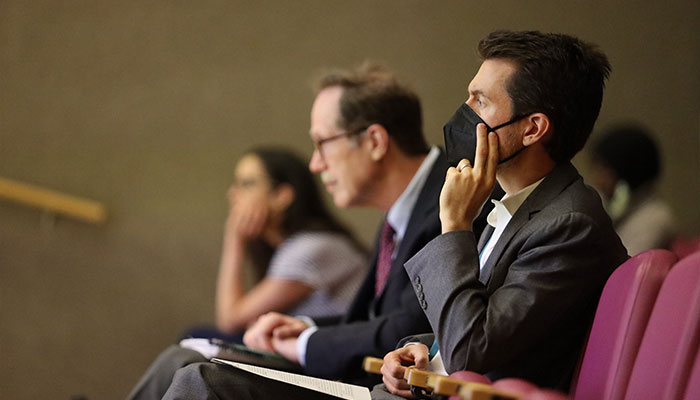
The 2022 Research Institute Scientific Symposium covered all things immunology and welcomed in-person attendees, including Dr. David Hill (near) and Dr. Ike Eisenlohr, chair of the event.
By droseyb [at] chop.edu (Barbara Drosey) and mccannn [at] chop.edu (Nancy McCann)
Children’s Hospital of Philadelphia Research Institute celebrated the onsite return of Poster Day and the Scientific Symposium, gathering in person May 26 for the first time in three years at Stokes Auditorium, which was buzzing with excitement.
Susan L. Furth, MD, PhD, Chief Scientific Officer at the Research Institute, welcomed attendees to this year’s symposium, themed “Harnessing the Immune Response: Breakthrough in Health and Disease,” and provided an overview of the day’s impressive agenda. A CHOP investigator chaired each of four themed sessions on immune dysregulation; hyperinflammation; immunometabolism: how biochemistry constrains biology; and immune monitoring, diagnostics, and therapeutics.
Laurence “Ike” Eisenlohr, VMD, PhD, 2022 Symposium Chair, said, “It’s a great time to be studying immunology. We are going to hear about some of the fantastic work that is going on, but it will really be just scratching the surface.”
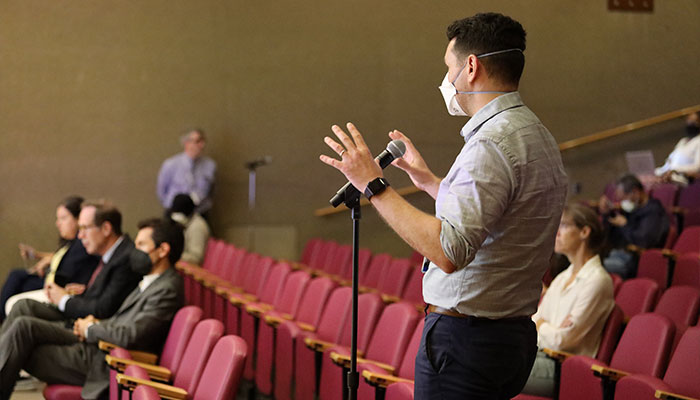
Mechanisms of Immune Dysregulation
Paula Oliver, PhD, co-chief, Division of Protective Immunity and scientific director for Core Facilities at CHOP Research Institute, chaired the first morning session on immune dysregulation.
Amit Bar-Or, MD, FRCPC, chief, Multiple Sclerosis Division, Department of Neurology, Perelman Center for Advanced Medicine at the University of Pennsylvania, delved into the metabolic dysregulation of B cells in patients with multiple sclerosis, a chronic inflammatory disease at its core. He is studying the inhibition of either mitochondrial respiration or of Bruton's tyrosine kinase, a non-receptor tyrosine kinase, and how it may reverse the abnormal respiration state and inflammatory response of B cells in patients with MS.
Next to the stage was Michael Silverman, MD, PhD, of the Division of Infectious Diseases at CHOP and assistant professor of Pediatrics in the Perelman School of Medicine at the University of Pennsylvania, who studies the human early-life microbiome and anti-commensal immune response, specifically related to type 1 diabetes. He presented findings from his investigation of how to leverage early-life commensal microbes to prevent autoimmunity.
Dr. Silverman and his team generated an animal model of an early-life microbiome in a nine-member pediatric-defined community of bacterial strains (PedsCom) by choosing microbes based on abundance, taxonomic diversity, and metabolic capability to develop a consortium that is specific and representative of the preweaning microbiome.
Next steps for this work include the development of new tools, such as T-cell receptor transgenic specific for PedsCom microbial antigens; the improvement of PedsCom protection with the addition of immunomodulatory microbes; and investigating whether the mechanism of protection is mediated by microbial peptides and/or metabolites.
Additional speakers on immune dysregulation included Melanie Ruffner, MD, PhD, Division of Allergy and Immunology at CHOP, who is examining how interferon signaling affects epithelial function in an in vitro 3D epithelial organoid model. Asif Dar, PhD, a research associate and postdoctoral fellow with the Oliver Lab at CHOP, is interested in CUL4B inhibition as a potential approach to tone down T cell immunity for conditions such as type 1 diabetes, organ transplant, MS, and inflammatory bowel disease. CUL4B is a protein expressed in the nucleus that regulates cell function and development in mice and, in humans, it has been implicated in X-linked intellectual disorders, as well as mutated in pancreatic adenocarcinomas and some lung cancers.
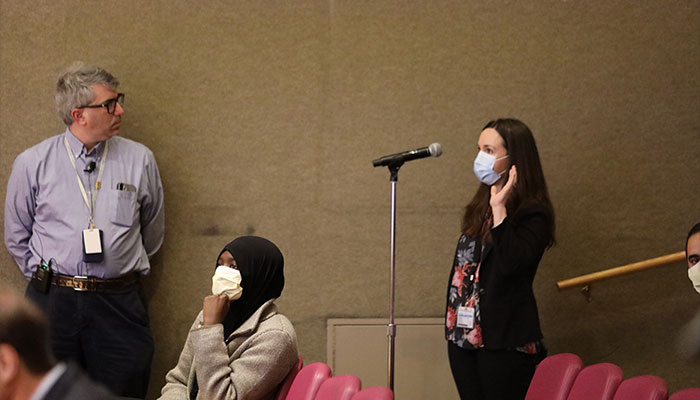
Dr. Laura Vella at mic with Dr. Ed Behrens.
Many Faces of Hyperinflammation
Edward Behrens, MD, chief, Division of Rheumatology, chaired the second morning session that focused on hyperinflammation. Hamid Bassiri MD, PhD, in the CHOP Division of Infectious Diseases and assistant professor of Pediatrics in the Perelman School of Medicine, discussed a hot topic in the field: “Unravelling the MISC-tery of the Multisystem Inflammatory Syndrome in Children.” MISC is the novel condition in children that is linked to SARS-CoV-19 infection and presents with a combination of clinical features that make detection challenging. Breath metabolites and immune biomarkers may serve as diagnostic tools for early identification of MISC using volatile organic compounds collected from the breath, as in the work of Audrey Odom John, MD, PhD, chief of the Division of Infectious Diseases.
“Making a proper diagnosis early on is critical, but we haven’t mastered that yet,” Dr. Bassiri said.
MISC is characterized by immune dyregulation, including explanded plasmablasts, expanded TCRVb21.3 T cells with CX3CR1 expression, and elevations in interleukin-10 and gamma interferon. Researchers theorize MISC may result from persistence of the SARS-CoV-19 virus in the gastrointestinal tract and abnormal GI permeability. Research is ongoing with a multidisciplinary team of scientists across CHOP and Penn.
Scott W. Canna, MD, in the CHOP Division of Rheumatology and Immune Dysregulation and assistant professor of Pediatrics in the Perelman School of Medicine, shared insights from his work to leverage HLH susceptibility factors to understand T-cell hyperactivation through the lens of his research focus on the role of interleukein-18 in auto- and hyperinflammatory diseases. Dr. Canna and his team aim to uncover the nature of the antigen that drives hyperinflammation and spontaneous hemophagocytic lymphohistiocytosis/macrophage activation syndrome.
Mayaan Levy, PhD, assistant professor in the Department of Microbiology in the Perelman School of Medicine, is exploring how to design diets that could prevent or arrest intestinal tumorigenesis. She is studying metabotherapy for intestinal diseases with a focus on suppressing colorectal cancer, specifically to see if a ketogenic diet that produces beta-hydroxybutyrate results in tumor shrinkage or suppression in both animal and human cell-derived organoids.
Tamir Diamond, MD, Transplant Hepatology fellow at CHOP, closed the morning session with his examination of interferon-gamma (IFN-y) in acute hyperinflammatory hepatitis. Pediatric acute liver failure has a high rate of morbidity and mortality and, unlike liver failure in adults, demonstrates evidence of immune dysregulation. In research involving lymphocytic choriomeningitis virus in an animal model, four groups demonstrated that mediators of liver injury are driven by the hepatic IFN-y response.
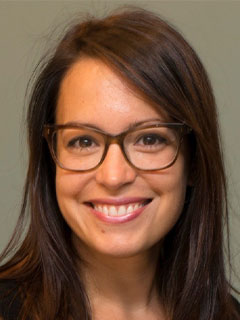
Galit Alter, PhD
Keynote Address: Systems Serology in the Context of Three Respiratory Pathogens
Galit Alter, PhD, professor of Medicine at Harvard Medical School and co-director, Harvard Center for AIDS Research, joined the symposium virtually for her presentation focused on work to define correlates of immunity for three prevalent respiratory viruses: respiratory syncytial virus infection (RSV), influenza, and SARS-CoV-2. Dr. Alter discussed the use of systems serology, a combination of high throughput experimental techniques to dissect antibody features and functions. Computational methods are then utilized to provide unparalleled understanding of the profiled antibodies.
“These are three different viruses for which we can use this tool to identify effective ways to develop vaccines that clear infection,” Dr. Alter said. “We are learning how antibodies interact with the immune system in new and unexpected ways.”
For example, two out of three adults get RSV each year, independent of when they last encountered the virus, and it is the leading cause of viral infant death. Systems serology revealed a minimal set of six features that can be used to predict who will and won’t become infected and determined that ospinophagocytic functions likely work in collaboration with neutralization to achieve maximal protection against RSV.
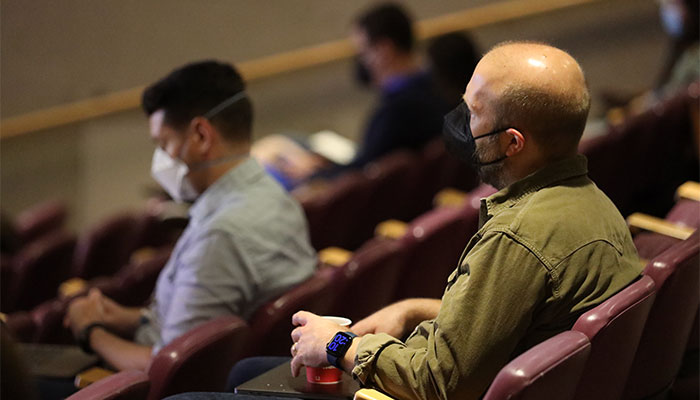
Immunometabolism: How Biochemistry Constrains Biology
The first afternoon session, chaired by scientist Sarah Henrickson, MD, PhD, in the Division of Allergy and Immunology, highlighted the works of the Research Institute’s up-and-coming scientists.
Brad Lindell, MD, an assistant professor of Anesthesiology and Critical Care and an attending physician in CHOP’s Pediatric Intensive Care Unit, focused his presentation on how recent COVID studies can inform how patient immune phenotypes may allow for precision immunomodulation in high-risk pediatric sepsis patients. Through an ongoing, prospective cohort study of children with critical illness, Dr. Lindell and his team are using proteomics, flow cytometry, and immunometabolic profiling to identify features associated with immune dysfunction in pediatric sepsis and determine the association between T cell dysfunction and clinical outcomes.
Kelly Rome, PhD, a postdoctoral fellow in the Bailis Lab, spoke about how T cell activation, proliferation, and function require extensive metabolic reprogramming. She has uncovered distinct roles for the branched chain amino acids in regulating each of these biological processes in T cells. Her research looks to discover how metabolism and signaling downstream of various nutrients integrate with metabolic and functional programming of T cells. This work has important implications for understanding how T cells function in metabolic disorders, as well as in nutrient-restricted environments such as the tumor microenvironment.
Sam McCright, a MD/PhD candidate in the Hill Lab, discussed his research into the effects of obesity on pulmonary macrophages. His work suggests that changes to lung macrophage cellular metabolism that occur in obesity are associated with the activation of inflammatory pathways implicated in the development of obesity-associated asthma. As obesity-associated asthma is often resistant to standard-of-care treatment, this work may further the development of novel targeted therapeutics for this severe disease.
Ceire A. Hay, a PhD student in the Henrickson Lab, gave a virtual presentation titled “Interrogating mechanisms of CD8 T cell dysfunction in pediatric obese asthma.” Her research findings showed that CD8 T cells are skewed toward an “exhausted-like” phenotype in obese asthmatic children. Most notably, there was increased levels of serum amyloid A, an early and sensitive blood biomarker for tissue injury and inflammation, in the serum of both animal models and obese pediatric patients with asthma.
Christoph Thaiss, PhD, an assistant professor of Microbiology at the Penn Institute for Immunology in the Perelman School of Medicine of the University of Pennsylvania, closed out the session with his presentation, “Environmental control of human disease,” which covered how immune cell rhythmicity is lost with age.
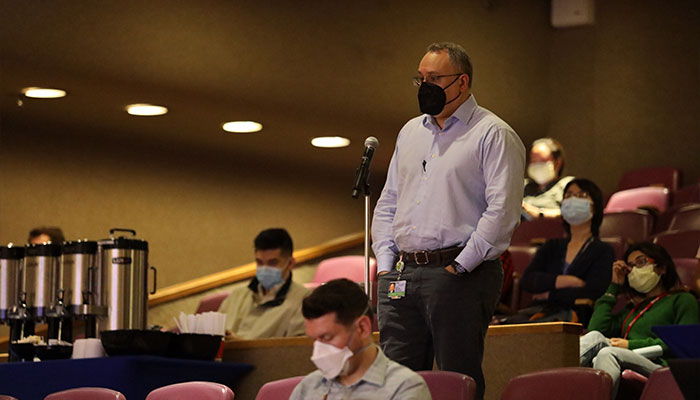
An attentive audience with many questions for the speakers, including one from Dr. Hamid Bassiri.
Immune Monitoring, Diagnostics, and Therapeutics
David Hill, MD, PhD, an attending physician in the Division of Allergy and Immunology, chaired the last session of the day, the capstone of the symposium.
Carole Le Coz, PhD, a research associate in the Romberg Lab of the Division of Allergy and Immunology, spoke about strategies to investigate novel diseases of immunity. Using the recently published PU.1 agammaglobulinemia syndrome as an example, Dr. Le Coz described how a strong collaboration between a dedicated team of scientists, physicians, and patients is the key to making meaningful scientific breakthroughs. Dr. Le Coz will soon apply this strategy to other disease discovery projects to her own lab in Toulouse, France.
Laura Vella MD, PhD, attending physician in the Division of Infectious Diseases, spoke about determining precision measures of when the recovering immune system is ready to respond to vaccines again, after cancer therapy and transplantation. Vaccine responses occur in lymph nodes, and T follicular helper cells (Tfh) are required. Focusing on Tfh and what they look like in the connecting space between the lymph node and the blood, she has discovered that Tfh in the blood come from lymphoid tissue. This means that the blood can be used as a periscope into the lymph nodes to understand whether these required cells have returned.
Tfh in blood “could potentially serve as a real-time read of what’s happening in that lymph node tissue,” Dr. Vella said.
Adeline Vanderver, MD, program director of the Leukodystrophy Center of Excellence and an attending physician in the Division of Neurology, presented on Aicardi-Goutières syndrome, a rare genetic disorder that affects the brain, spinal cord, and immune system, and the molecular mechanisms of a therapeutic, baricitinib. Dr. Vanderver is studying how baricitinib, with careful monitoring, may be considered in disease modification in AGS, and if it is well tolerated. Her ongoing research offers proof of principle that AGS is a treatable disorder.
Closing out the Scientific Symposium was Caroline Diorio, MD, an attending physician with the Cancer Center, whose presentation centered on using serum proteomics to identify novel and targetable biomarkers for cytokine release syndrome (CRS), and immune effector cell-associated neurotoxicity syndrome (ICANS) after CAR T-cell therapy for patients with relapsed B-cell acute lymphoblastic leukemia (B-ALL). Her research looks at serum MILR1 and FLT3 levels as potential pre-infusion biomarkers for the development of severe CRS in pediatric B-ALL. She also is studying the association of cytokine IL-18 with ICANS onset and whether it is a potential therapeutic target.
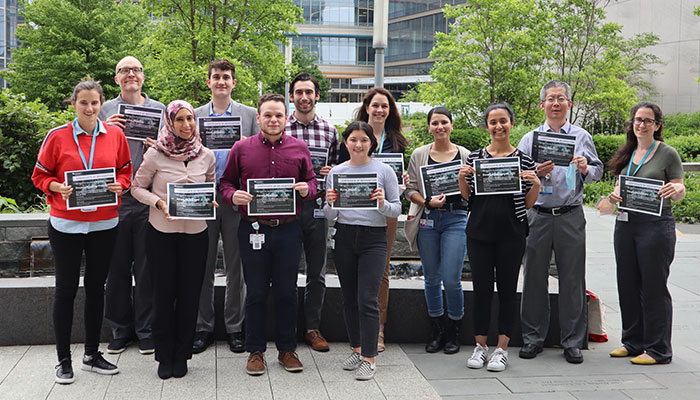
Poster winners are all smiles.
Poster Awards
A reception and poster awards ceremony took place in the lobby of Colket Translational Research Building after the conclusion of the Symposium. At this year’s 29th annual CHOP Research Poster Day, 20 awards recognized basic science laboratory-based researchers, and 20 awards recognized the clinical researchers presenting posters.
John Weaver’s research project, “Deep Learning Imaging Features Derived From Renal Ultrasounds Predict Chronic Kidney Disease Progression in Children With Posterior Urethral Valves” won for Most Promising Research supported by Arcus. And Matthew Aronson’s “Drug-Eluting Endotracheal Tubes for Preventing Bacterial Inflammation in Subglottic Stenosis,” won for Most Promising Research related to a pediatric medical device sponsored by the Pennsylvania Pediatric Medical Device Consortium (PPDC). Both scientists received travel grants.
Judges based their decisions on the scientific merit of the presenters’ research, the quality of their posters, and the strength of their oral presentations. Congratulations to all the winners!